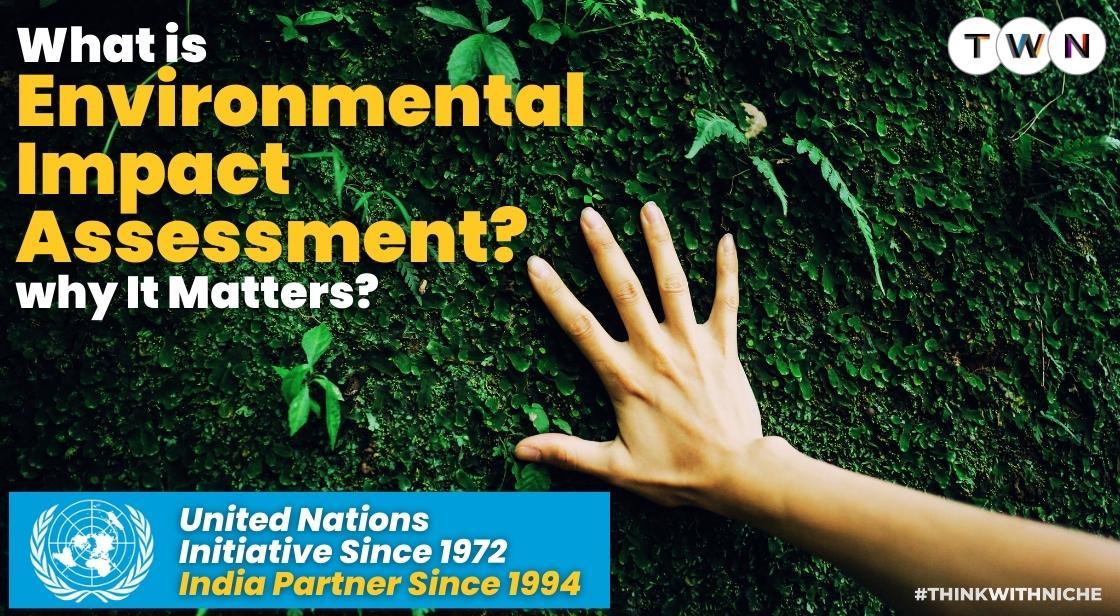What is Environmental Impact Assessment and why It Matters?

Blog Post
Delving into the realm of upcoming projects or activities, the Environmental Impact Assessment (EIA) stands as a structured beacon, illuminating the potential environmental effects that could unfold.
It is a proactive method, a lens through which we peer into the future impact on our natural surroundings before the wheels of projects are set in motion.
Emerging in the dynamic landscape of the 1960s and 1970s, the concept of EIA was a responsive chord struck in the face of mounting concerns about the environmental repercussions of large-scale development endeavors.
The inaugural EIA notification from the Union Ministry of Environment and Forests, Government of India, on 27 January 1994, marked a pivotal moment, formalizing the need for a systematic approach to assess and mitigate the potentially devastating impacts of projects like dams, highways, and industrial facilities on ecosystems and communities.
Globally, the importance of EIA echoes through the corridors of international conventions and agreements. The United Nations Conference on the Human Environment in Stockholm in 1972 was a resounding declaration, underscoring the imperative of environmental assessment in decision-making processes.
Further, heavyweight agreements such as the United Nations Framework Convention on Climate Change (UNFCCC) and the Convention on Biological Diversity (CBD) have lent their weight to the cause, emphasizing the critical role of considering environmental impacts across diverse sectors.
In this exploration of the EIA terrain, we unravel not just a method but a commitment to informed, sustainable decision-making—a commitment that resonates globally, transcending borders and echoing through the interconnected tapestry of our shared environment.
In the ever-evolving landscape of environmental conservation and sustainable development, Environmental Impact Assessment (EIA) emerges as a crucial tool. This article navigates through the core aspects of EIA, elucidating its significance in today's dynamic world.
Environmental Impact Assessment (EIA) is a systematic process designed to identify, assess, and mitigate the potential environmental impacts of proposed projects, policies, or activities.
With the escalating concerns about climate change, biodiversity loss, and ecological degradation, the importance of EIA has become more pronounced than ever.
What is Environmental Impact Assessment and why It Matters?
Environmental Impact Assessment (EIA) stands as a fundamental and proactive mechanism in the realm of sustainable development, playing a pivotal role in foreseeing and addressing potential environmental consequences before they reach irreversible stages.
This overview delves into the core components of EIA, emphasizing its contemporary significance through the integration of scientific methodologies, stakeholder engagement, and regulatory frameworks.
EIA in Action: Navigating Sustainable Development
Environmental Impact Assessment operates as a navigational tool in the dynamic landscape of sustainable development. Its proactive nature distinguishes it as a preemptive strategy, aiming to identify and mitigate potential environmental impacts from the inception of development projects. The latest updates in EIA practices underscore its evolving nature, adapting to the changing dynamics of global environmental challenges.
Scientific Methodologies: Advancements and Precision
Recent years have witnessed significant advancements in scientific methodologies applied in EIA. Cutting-edge technologies, such as Artificial Intelligence (AI) and machine learning, are enhancing the precision and predictive capabilities of impact assessments. These tools enable a more nuanced understanding of potential environmental repercussions, empowering decision-makers with data-driven insights.
Stakeholder Engagement: A Paradigm of Inclusivity
Stakeholder engagement remains a cornerstone of effective EIA implementation. In the latest updates, there is a growing emphasis on fostering inclusivity in decision-making processes. Examples abound where EIA practices involve not only local communities but also global stakeholders, recognizing the interconnectedness of environmental issues in a globalized world.
Example: Offshore Wind Farm Project
Consider the case of a proposed offshore wind farm project. Robust stakeholder engagement in the EIA process involves coastal communities, environmental NGOs, and international bodies concerned with marine ecosystems. By including diverse perspectives, potential impacts on marine life, navigation routes, and local economies are comprehensively assessed.
Regulatory Frameworks: Evolving to Address Contemporary Challenges
Regulatory frameworks governing EIA are continually evolving to address contemporary environmental challenges. Governments worldwide are revisiting and enhancing environmental legislation to ensure that EIA processes align with the latest scientific knowledge and global sustainability goals.
Example: Net-Zero Commitments
In response to the global push for net-zero emissions, regulatory frameworks are adapting. EIA processes now increasingly include assessments of projects' contributions to carbon neutrality and adherence to renewable energy standards.
Unveiling the Stages of the Environmental Impact Assessment (EIA) Process: A Comprehensive Exploration
The Environmental Impact Assessment (EIA) process unfolds through distinct stages, each serving a crucial purpose in evaluating and mitigating potential environmental consequences. This comprehensive exploration delves into the latest updates and examples across the stages of EIA, shedding light on the evolving nature of this essential mechanism.
1. Screening: Identifying Projects Warranting EIA
The screening stage involves a preliminary assessment to identify projects that require a comprehensive EIA. In the latest updates, advancements in screening methodologies leverage Geographic Information Systems (GIS) and satellite imagery for a more precise identification of projects with significant environmental implications.
Example: Urban Redevelopment Project
Consider an urban redevelopment project aiming to transform a brownfield site into a commercial complex. Modern screening techniques can analyze the project's spatial impact, considering factors such as land use, biodiversity, and proximity to water bodies.
2. Scoping: Defining the Scope of EIA
Scoping outlines the boundaries of the EIA, determining the environmental factors and impacts to be considered. In recent developments, scoping has become more inclusive, incorporating feedback from stakeholders and recognizing the interconnectedness of environmental aspects.
Example: High-Speed Rail Project
For a proposed high-speed rail project, scoping involves engaging with communities along the route. The scope extends beyond direct impacts on flora and fauna to encompass noise pollution, community disruption, and potential alterations to local ecosystems.
3. Baseline Assessment: Establishing Environmental Baselines
The baseline assessment phase involves establishing the current environmental conditions of the project area. The latest updates emphasize the use of advanced technologies such as LiDAR (Light Detection and Ranging) and remote sensing for precise and real-time baseline data.
Example: Mining Exploration Project
In a mining exploration project, baseline assessment incorporates data on air quality, water quality, and biodiversity. Advanced technologies enable continuous monitoring, providing a dynamic understanding of baseline conditions.
4. Impact Prediction: Anticipating Environmental Consequences
Impact prediction involves evaluating potential impacts based on project activities. Latest methodologies integrate modeling and simulation tools, allowing for more accurate predictions of environmental consequences.
Example: Hydroelectric Dam Construction
For a hydroelectric dam project, impact prediction includes assessing potential alterations to river ecosystems, sedimentation patterns, and downstream water quality. Advanced modeling helps visualize and quantify these potential impacts.
5. Mitigation and Impact Management: Developing Strategies for Sustainability
This stage focuses on devising measures to mitigate identified impacts. Contemporary approaches prioritize sustainable development, aiming to offset or minimize negative consequences while maximizing positive contributions.
Example: Highway Construction Project
In a highway construction project, mitigation measures might include wildlife corridors, noise barriers, and eco-friendly construction materials. The goal is to balance infrastructure development with ecological preservation.
6. Public Consultation: Ensuring Inclusivity and Transparency
Public consultation has gained prominence as a critical stage in the EIA process. In the latest updates, digital platforms and virtual engagement tools have become integral, fostering broader participation and transparency.
Example: Renewable Energy Project
For a proposed wind energy project, public consultation extends beyond local communities to include online forums and virtual town halls. This ensures that diverse voices are heard, considering the broader implications of renewable energy initiatives.
7. Monitoring and Post-Assessment: Ensuring Accountability and Adaptability
The final stages involve ongoing monitoring of the project's environmental performance and a post-assessment to evaluate the effectiveness of mitigation measures. In the latest developments, technologies like Internet of Things (IoT) sensors contribute to real-time monitoring.
Example: Urban Development Project
For an urban development project, continuous monitoring assesses factors like air quality, traffic patterns, and green space utilization. Post-assessment evaluates whether sustainability goals were achieved and informs future projects.
The Crucial Importance of Environmental Impact Assessment (EIA):
Preserving Biodiversity: A Global Imperative
Biodiversity loss is a pressing global concern. EIA plays a pivotal role in safeguarding ecosystems by assessing and mitigating potential threats to biodiversity. Through thorough evaluations, EIA aids in the identification of measures to protect flora and fauna, ensuring the balance of delicate ecological systems.
Mitigating Climate Change Impacts
As the world grapples with the impacts of climate change, EIA becomes an essential tool to assess the carbon footprint of projects. It enables the identification of strategies to minimize greenhouse gas emissions, promoting a low-carbon development trajectory.
Empowering Stakeholder Engagement
EIA fosters transparent and inclusive decision-making processes by involving stakeholders from the early stages of project development. This engagement ensures that local communities, indigenous groups, and other concerned parties have a say in shaping projects that directly affect their environment and livelihoods.
Ensuring Sustainable Development Goals (SDGs) Alignment
EIA serves as a linchpin in achieving the Sustainable Development Goals (SDGs). By scrutinizing projects through the lens of environmental, social, and economic impacts, EIA contributes to the realization of SDGs, fostering a holistic approach to development.
The Latest Data and Global Trends:
Growing Global Adoption of EIA Practices
Recent data indicates a surge in the adoption of EIA practices worldwide. Governments, corporations, and international bodies are increasingly recognizing the need for comprehensive impact assessments to navigate the complexities of modern development.
Technological Innovations in EIA
Advancements in technology, including Geographic Information Systems (GIS) and remote sensing, have revolutionized the way EIA is conducted. These tools enhance the accuracy of impact predictions, providing a more nuanced understanding of potential environmental repercussions.
Also Read : Climate Change and its Impact on Global Business Landscape
EIAs typically consider a wide range of environmental impacts, including:
1. Air Quality: Navigating Atmospheric Concerns
The assessment of air quality in EIAs involves examining the potential emissions and pollutants released into the atmosphere. The latest updates leverage advanced air quality modeling and monitoring technologies for real-time assessments.
Example: Industrial Expansion
ProjectIn the context of an industrial expansion project, advanced sensors and modeling tools can predict the dispersion of pollutants, ensuring that air quality standards are adhered to.
2. Water Quality: Safeguarding Aquatic Ecosystems
EIAs meticulously scrutinize potential impacts on water bodies, assessing the quality of surface and groundwater. Contemporary approaches incorporate data from remote sensing and satellite imagery for more comprehensive water quality evaluations.
Example: Hydropower Dam Construction
For a proposed hydropower dam, water quality assessments extend to factors such as sedimentation, nutrient levels, and potential alterations to aquatic habitats.
3. Land Use: Balancing Development and Conservation
The evaluation of land use in EIAs considers how proposed projects impact existing land functions. The latest updates emphasize a holistic approach, integrating Geographic Information Systems (GIS) for spatial analysis.
Example: Urban Redevelopment Plan
In an urban redevelopment plan, GIS tools can assess the spatial implications of the project, considering factors like green spaces, infrastructure density, and potential effects on local ecosystems.
4. Noise Pollution: Gauging Auditory Impacts
EIAs examine the potential noise emissions from projects, especially those in urban or sensitive environments. Advancements in noise mapping technologies contribute to a more nuanced understanding of potential impacts.
Example: Transportation Infrastructure Expansion
For a proposed expansion of transportation infrastructure, noise mapping tools can predict sound propagation, helping design mitigation measures such as noise barriers.
5. Traffic Congestion: Evaluating Mobility Impacts
Transportation projects undergo thorough assessments of potential impacts on traffic patterns and congestion. The latest updates integrate smart transportation data for dynamic modeling.
Example: New Highway Construction
In the case of constructing a new highway, EIA considerations extend to potential changes in traffic flow, the introduction of alternative transportation modes, and associated emissions.
6. Habitat Loss: Safeguarding Ecosystems
The assessment of habitat loss in EIAs addresses potential impacts on ecosystems and wildlife habitats. Modern approaches incorporate habitat mapping and connectivity analysis.
Example: Residential Development Project
For a residential development project, habitat loss assessments consider the fragmentation of natural habitats and potential impacts on local flora and fauna.
7. Biodiversity Impacts: Preserving Species Diversity
EIAs focus on biodiversity impacts, evaluating how projects may affect the richness and variety of species in a given area. Advanced biodiversity monitoring techniques contribute to more accurate assessments.
Example: Infrastructure Expansion in Ecologically Sensitive Areas
In areas with high ecological sensitivity, such as wetlands or forests, EIAs assess potential impacts on biodiversity, recommending measures like conservation zones and wildlife corridors.
8. Cultural Heritage Impacts: Respecting Historical Significance
The consideration of cultural heritage impacts in EIAs involves assessing potential effects on archaeological sites, historical structures, and cultural landscapes.
Example: Tourism Development in Historic Regions
For a proposed tourism development project in a historic region, EIA evaluations include potential impacts on heritage sites, recommending preservation measures and sustainable tourism practices.
Also Read : Alarming Facts About Climate Change and its impact on our planet
EIAs can be conducted for a variety of projects, including:
-
New roads and highways
-
Power plants
-
Mining operations
-
Industrial facilities
-
Dams and reservoirs
-
Urban development projects
Why EIA Matters ?
EIA is important for a number of reasons.
First, it helps to identify and avoid potential environmental problems. By carefully considering the potential impacts of a proposed project, EIA can help to prevent problems such as air and water pollution, habitat loss, and noise pollution.
Second, EIA can help to reduce the severity of environmental impacts. Even if it is not possible to avoid all environmental impacts, EIA can help to identify ways to reduce the severity of those impacts. For example, an EIA might recommend using cleaner technologies or taking steps to mitigate the impact of noise pollution.
Third, EIA provides an opportunity for public participation in decision-making. The public can provide input on the potential environmental impacts of a proposed project and on how those impacts can be mitigated. This helps to ensure that the decision-making process is transparent and accountable.
Latest and updated data and facts
-
According to the International Association for Impact Assessment (IAIA), over 150 countries have laws or regulations requiring EIAs for certain types of projects.
-
The World Bank estimates that EIAs have helped to avoid or mitigate over $1 trillion in environmental damage since 1990.
-
A study by the European Commission found that EIAs have helped to reduce air pollution by 10% and water pollution by 15% in the European Union.
Conclusion:
In conclusion, Environmental Impact Assessment stands as a linchpin in fostering sustainable development practices. Its role in preserving biodiversity, mitigating climate change impacts, empowering stakeholders, and aligning with global goals underscores its paramount importance in shaping a harmonious coexistence between human activities and the environment.
As we navigate an era marked by environmental challenges, the relevance of EIA becomes more pronounced than ever. It serves as a beacon guiding us toward responsible and sustainable development, where progress harmonizes with the delicate balance of nature.
You May Like
EDITOR’S CHOICE












